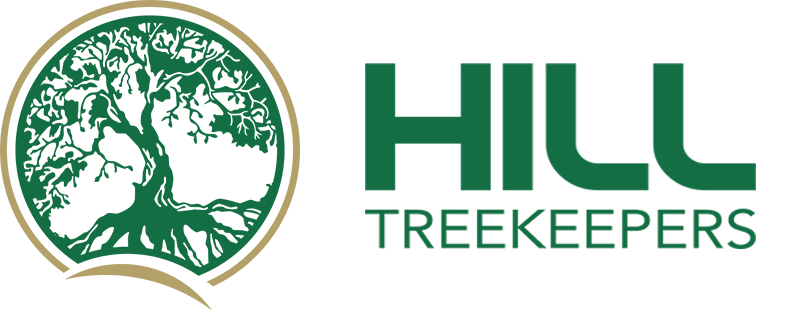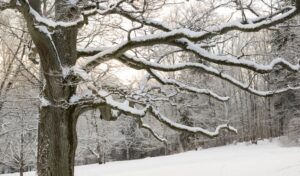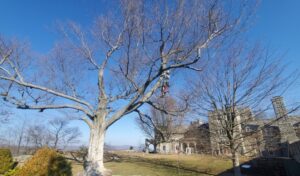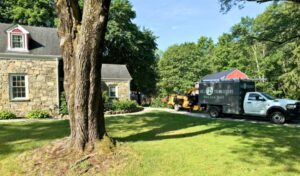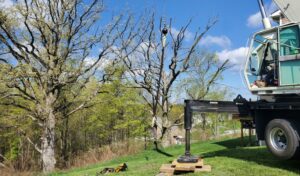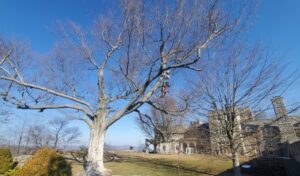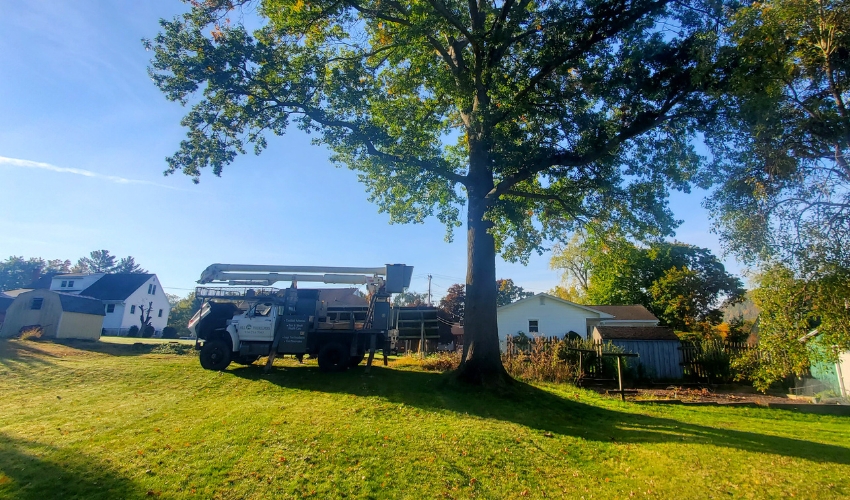
Summer in the Hudson Valley is the perfect time to check up on your trees’ health. With trees fully leafed out, many problems are more evident than in other seasons. For example, you may find that your tree lacks nutrients, needs pruning, or is being affected by pests or diseases.
In this article, we provide a helpful summer tree care checklist for the Hudson Valley area of New York. This checklist outlines what to look for during the summer season and why it’s essential to follow each step. By following this handy guide (or hiring an arborist to take care of it for you), you’ll have healthy and beautiful trees that will bring joy for generations to come.
PLAN AHEAD: Prepare for upcoming seasons with our seasonal tree care checklists.
Key Takeaways
- Summer is the perfect time to conduct a tree inspection, as you can see the tree in full leaf.
- Pests and diseases are often most visible in the hot summer months; look for any increased insect activity next to your tree and typical signs of disease (such as discolored leaves, early leaf drop, dead branches, and spots on the bark).
- Monitor the weather for drought warnings and provide supplemental water to trees when the soil is dry. Water under the drip edge and avoid getting the trunk wet.
- A professional can install cables and braces in your trees to lower the risk of broken branches during summer thunderstorms.
- Other summer tree care checklist items include testing the soil for nutrient deficiencies, removing dead trees while the ground is dry, pruning out deadwood, and checking the mulch around a tree.
8 Steps to Summer Tree Health in the Hudson Valley
Summer is the best time to get outside in the Hudson Valley, so why not head out to inspect your trees and ensure there aren’t any underlying problems?
1. Prune Deadwood or Infected Branches as Soon as You Notice Them
Truthfully, there is no wrong time to prune dead branches from your trees. But pruning deadwood is a perfect summer activity, as you can see a tree leafed out and better identify dead or diseased branches and twigs.
Summer also allows you to perform pruning to shape the tree or to clear the crown (the branches and leaves of a tree). Crown clearing increases airflow and light penetration, lowering the risk of diseases and encouraging fruit production in fruit trees.
2. Monitor for Insect and Pest Activity Around Your Trees
While the Hudson Valley area is beautiful and full of diverse trees, they are under threat from several pests. Many typical pests are particularly active in the summer, meaning a vigilant eye can catch an infestation before it gets out of control.
Some of the common insects in the Hudson Valley that are active in the summer include:
- Spongy moths: Spongy moths are an invasive species that defoliate trees. In July, you may notice the appearance of adult moths. Most defoliation happens when they are in their caterpillar stage, but identifying and killing adults will help control the population for future seasons.
- Spotted lanternflies (SLF): Spotted lanternflies are an invasive pest that has become a pressing concern for us in the Hudson Valley. SLF extracts sap from trees and produces honeydew that attracts more pests. Adults are typically active in the summer, and New York’s government urges residents to report any sightings.
- Boxwood mites: Boxwood shrubs are popular in the Hudson Valley as deer generally don’t eat them. Boxwood mites typically appear in the early summer and cause tiny, white pinpricks on leaves or cause defoliation with severe infestation.
- Emerald ash borers (EAB): EAB is an invasive species responsible for killing untold ash trees across America. Since the initial discovery, New York has confirmed EAB infestations in nearly every county. EAB typically kills trees within four years, and the government asks residents of the Hudson Valley to report any sightings.
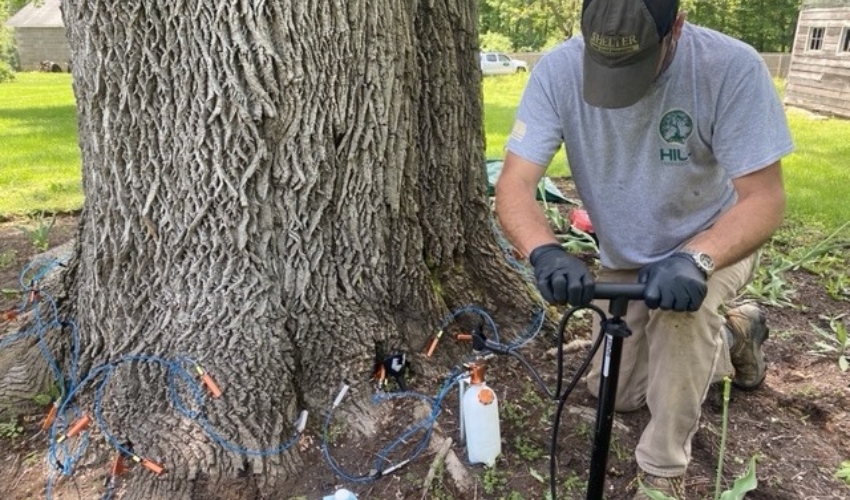
An arborist from Hill Treekeepers injecting an insecticide treatment into the base of a tree. From there, the treatment is taken up by the tree and spread throughout the entire canopy to prevent insect damage.
3. Watch for Typical Signs of Tree Diseases
Prevention is the best way to protect your trees from diseases, but early detection is the next best thing. Many tree diseases spread most quickly in the summer when the weather encourages transmission. Disease damage can range from minor aesthetic damage on leaves to the death of mature trees.
If you detect or suspect your tree has a disease, speak with an arborist about the next steps. Depending on the diagnosis, they may recommend a treatment plan to control the disease or suggest removal to limit its spread.
Tree diseases manifest in different ways and produce various symptoms, but some common signs of a diseased tree include:
- Wilting leaves
- Holes in the leaves
- Early leaf drop
- Spots on fruit or bark
- Discolored leaves
- Dead branches
- Increased pest activity
- Fuzzy or moldy patches on leaves
WARNING: Determining the exact problem with your tree and a proper treatment plan is best left to a tree care professional. Many diseases produce similar symptoms and sometimes the symptoms may be a sign of something unrelated to disease, such as drought or lack of specific nutritients. Contact an ISA Certified Arborist immediately if you notice any of these symptoms on your trees.
4. Provide Supplemental Water During a Drought
Summer heat combined with a lack of rainwater can lead to drought conditions. Under normal conditions, you likely won’t have to water established trees, but drought may necessitate supplemental water.
In the Hudson Valley, we are not exposed to many long-term droughts, but there have been stretches of drought conditions in recent years. For instance, in Dutchess County in 2022, many residents experienced drought conditions throughout August. Orange and Ulster counties have similar drought patterns.
Some of the common drought signs to watch for in trees include:
- Wilting: Leaves may temporarily wilt during the day and recover by morning or remain permanently wilted if the drought is severe.
- Yellowing leaves: Leaves will look like they have their fall colors in the summer.
- Leaf drop: As the drought continues, trees slowly lose their leaves. Eventually, you may notice leafless patches and dead branches in the tree canopy.
- Leaf scorch: Leaves will have brown edges and look burned.
- Bark cracks: A long-standing drought may lead to vertical cracks in the bark. We’ve observed these more often in species like maples.
To test if a tree needs water, dig a small hole about nine inches deep near the tree’s drip line (the area beneath the outer edges of the tree canopy) and examine the soil. If it is cool and moist, you likely won’t need to provide water. If not, use a soaker hose to water the soil under the tree canopy, avoiding the trunk.
WATERING TIP: Only water mature trees if they exhibit signs of drought damage and the forecast predicts no rain in the next few days. Recently planted trees should be watered regularly in summer regardless of drought conditions.
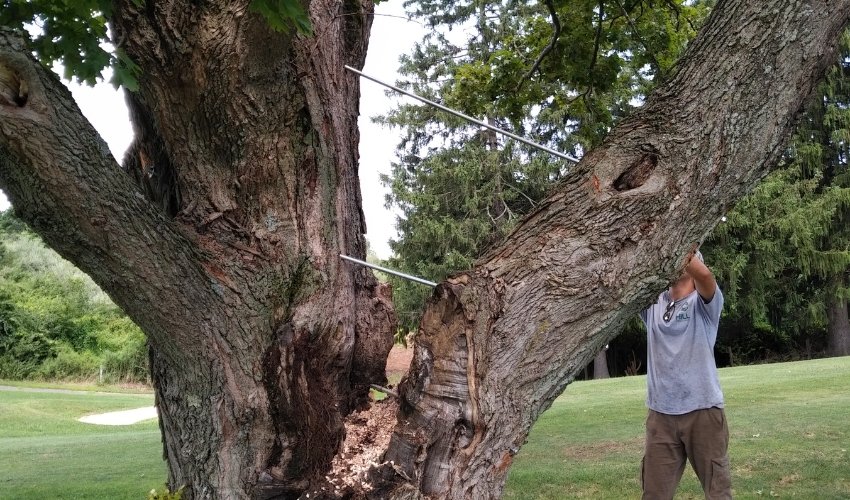
Although cables installed in trees are often nearly invisible, these extremely strong steel cables do an excellent job supporting overly long branches, holding together branches growing at a narrow angle (which makes the branch junction inherently weak), and preventing trees from splitting apart or dropping branches during summer thunderstorms.
5. Cable and Brace Weak Limbs That May Struggle to Withstand Storms
We’re no strangers to summer storm damage in the Hudson Valley, with heat waves often ending in powerful thunderstorms that bring down trees and knock out power to thousands of residents.
Cabling or bracing unstable trees and branches can lower the risk of storm damage. An arborist will look for weaknesses in a tree that may exacerbated by high winds, such as long, heavy branches, narrow branch crotches, or an imbalanced canopy.
Cabling holds multiple branches in place, limiting movement and the risk of breaking in a storm. Bracing involves placing a rod through branches to limit twisting during a storm.
DID YOU KNOW? While cabling and bracing can help minimize the risk of tree or branch failure, we can never say that a tree is 100 percent risk-free. As a living, ever-changing organism, a tree is constantly impacted by external conditions that may unexpectedly compromise it’s structural stability or exceed its ability to withstand the forces acting on it.
6. Order a Soil Test to Catch Any Nutrient Deficiencies
Trees need a robust supply of macro and micronutrients to support healthy growth and enhance resilience during the summer. A soil test may be in order if a tree grows slowly or looks generally unhealthy. These tests can determine if there is a nutrient deficiency affecting your tree and provide recommendations about the type and amount of fertilizer to use.
Avoid high-nitrogen fertilizers during the late summer, as they may promote too much new growth late in the growing season. This new growth will be unlikely to survive the winter, wasting the energy the tree expended in producing that growth and unnecessarily stressing it.
Soil nutrient testing is available through the Cornell Soil Health Laboratory.
7. Have a Professional Remove Dead Trees While the Ground is Dry
Summer is an excellent time for professional tree removal of any dead, diseased, or unwanted trees from your yard. When the weather is hot and dry, a tree care company can more easily minimize yard damage when performing tree removal services. Muddy yards, typical in spring and fall, can make the work difficult and messy.
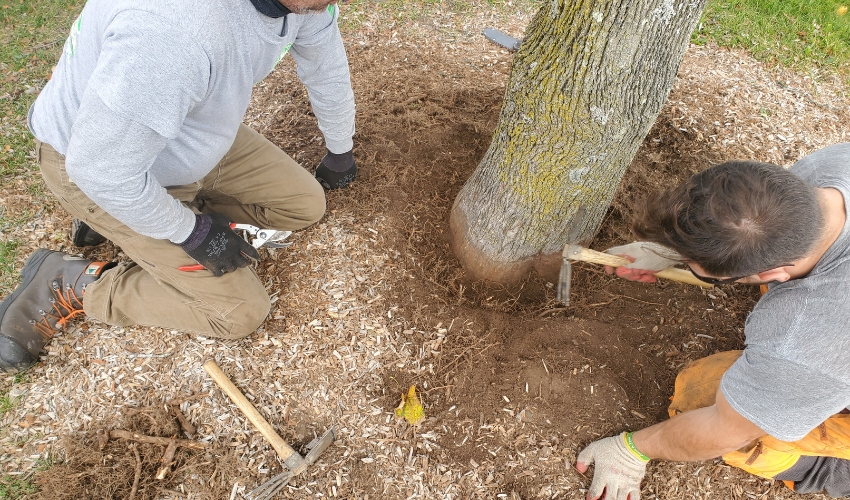
Todd Hill, ISA Certified Arborist and owner of Hill Treekeepers, exposing the root flare of a tree in Newburgh, NY that had too much mulch piled around it.
8. Check Mulch Around Trees and Add More if Needed
A layer of organic mulch provides many benefits for trees, such as limiting soil compaction, suppressing weed growth, and regulating soil temperature. Summer is the perfect time to check your mulch. Here’s what to do:
- Ensure you have a 2- to 4-inch layer of mulch: Ideally, the mulch layer around a tree should be about 2 to 4 inches deep. You may only need one inch when using a finely textured mulch. Add mulch if you notice it has depleted over time or remove mulch if you applied too much in the past. “Fluff it up” to allow water to better move through the mulch and percolate into the soil beneath.
- Extend mulch coverage out to the drip line: Mulch should extend to the edge of the tree canopy to protect your tree’s root zone. This area increases as the tree grows, so add mulch as needed each year.
- Keep mulch away from the tree trunk: Mulch should not touch the tree trunk or the root flare (the base of the trunk where it widens). Remove any mulch that is too close to the tree (keep it about 6 inches away from the trunk). Avoid volcano mulching at all costs; piling mulch around the tree trunk keeps the area permanently warm and moist, creating the perfect breeding ground for decay fungi that will rot out the base of your tree.
Let Hill Treekeepers Take Care of Your Summer Tree Care Checklist
New York summers in the Hudson Valley are a wonderful time to be outside (except, perhaps, during a heat wave). And while it’s an excellent time to inspect your trees for early warning signs of problems and perform general summer tree maintenance tasks, most residents in Ulster, Orange, and Dutchess Counties would rather go for a hike, lounge by the pool, or enjoy an outing with the kids.
That’s why our team of Certified Arborists at Hill Treekeepers, with locations in Newburgh and Saugerties, is here to help with any of your summer tree care checklist items. Our summer tree services cover everything your trees might need, including:
- a thorough tree inspection,
- diagnosis of any insect, disease, or other underlying problems,
- preventive and control/treatment strategies to restore trees to full health,
- pruning for tree health and structure,
- cabling and bracing to stabilize trees and mitigate safety risks,
- soil testing for nutrient deficiencies,
- deep root fertilization to correct nutrient problems,
- tree removal services,
- mulching around trees and landscape beds,
- recommendations for irrigation or watering schedules,
- and much, much more!
Call us at 914-584-7992 or request a quote online to schedule an appointment with one of our arborists. From there, we’ll take care of everything your trees need so you can enjoy the summer – and your healthy, beautiful trees.
Share this online!
Get the highest quality of tree services for residential and commercial properties in the Hudson Valley area. We look forward to working with you!
TOPICS
Recent Articles
Don't Miss the Next Update!
Join the thousands of smart Hudson Valley residents who get the monthly newsletter from Hill Treekeepers. It's full of helpful information you won't want to miss!
